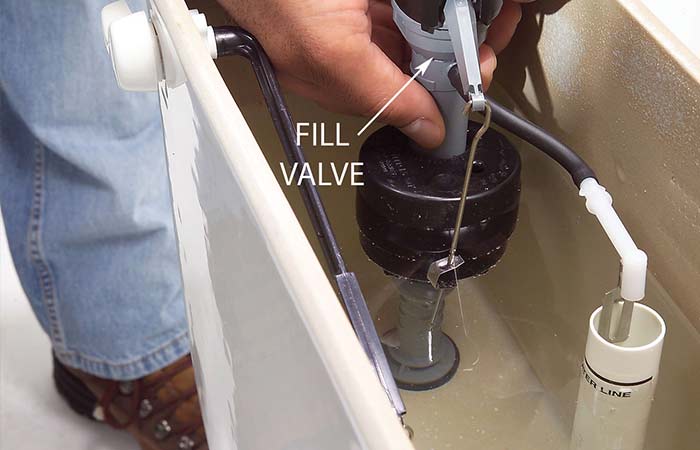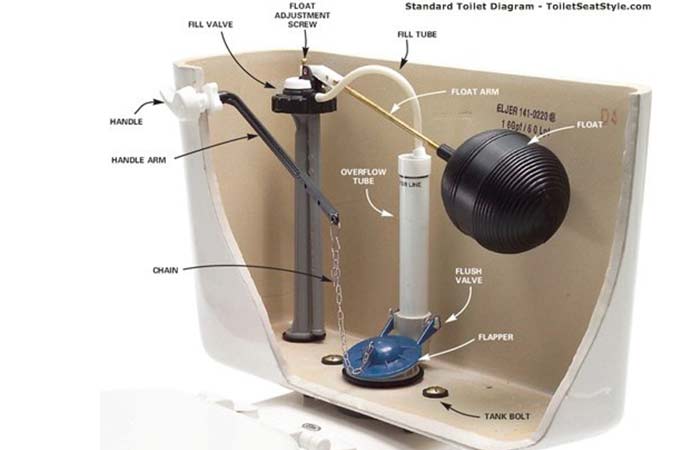Toilet Fill Valve Won’t Shut off/Not Working- Causes & Fixes
No matter the part of the house you are in, if you all of a sudden hear some running water, then you should consider checking your toilet. If the sprinklers are not on, chances are that you have a running toilet. This problem is usually caused by water continuously running out of your tank and into the bowl and preventing the valve from shutting off.
If this is happening, you might be wasting gallons of water daily. One way to mitigate this problem is first to establish the reason why you have a running toilet and later fix those issues.
Possible causes
There are many reasons why you might be having a running toilet in your home. The best place to start diagnosing these problems is by checking the flapper, the tank ball, or the flush valve. It is one of these areas where the problem might begin.

When replacing or replacing the flush valve and its components, you should always ensure that you turn off the water to your toilet. It is worth noting that the shut-off valve is usually located behind the toilet. The following could be the reasons why you have a running toilet in your home.
1. The flush valve
One of the first things to check in your toilet is the flush valve, where the flapper rests to seal the water in the tank. Is the valve smooth, or it has some rough spots or chips? It is worth noting that a rough or eroded flush valve could make your toilet to run. As a result, it should be replaced if the rim has already been compromised.
If you discover that the rim of the flush valve looks nice and smooth, but water is still passing by the flapper and flowing into the bowl, then chances are that the flapper is faulty or the tank ball is likely to be the problem.
2. Bad flapper
The flapper or tank ball could be cracked and can therefore fill with water when the tank is emptying. As a result, the flapper will close prematurely. Besides this, these components can become deteriorated in the long run. This can hinder them from providing the necessary seal and thereby allow water to pass through the bowl. Flappers and tank balls come in different types. Some flush valves usually use a cylinder with a flat seal. Therefore, the method to diagnose and repair such issues will vary from one toilet to another.
3. Loose flush lever
The other cause of running toilet could be that the flush lever is not tightly secured to the wall of the tank. If this is the case, you should try to reach into the tank and tighten the lock nut. Ideally, you should tighten it using your hand to prevent the possibility of cracking your porcelain. Besides this, you should ensure that all the parts of the flush valve are intact and not bending or separating.
There are instances when the flush lever might be in bad shape. If this is the case, you need to replace it with a new flush lever assembly.
4. Faulty fill valve
If your flush lever is working well and the flush valve is sealed well, but still the water continues to fill the tank and exit into the bowl through the overflow tube, chances are that the fill valve is faulty. Regular toilet tanks typically have an overflow tube that helps prevent water from spilling over the top of the tank and onto the floor of the toilet.
The fill valve is usually designed to shit off the water flow when the tank is already full. However, when the fill valve is not shutting off the water once the tank is full, chances are that the toilet fill valve is faulty. It could be dirty or even have some debris in it.
5. Check the fill height
The overflow tube in your tank usually prevents it from overfilling and flooding your bathroom. However, if the float cup is positioned too high, some water might actually enter your overflow tube and even flow into your toilet bowl. This will make the fill valve to turn on to top up your tank periodically.
Therefore, there is a need to adjust the fill height to set the water level properly. Ideally, it should neither be too high nor too low. There are some marks on the inside of the toilet tank that can help you know where the float should be so that to keep the toilet working optimally.
6. Faulty flush handle and flapper chain
The last thing that could make you have a running toilet in your home is a faulty flush handle and flapper chain. Sometimes, the flapper chain might be too short or can even get entangled. As a result, the flapper will not close, and the toilet will cycle endlessly. Ideally, the chain should be slightly slack when closed without any excess. It should neither be too tight nor too slack. If it is rusty, you should replace it.

Fixes
If you already have a running toilet, you can readily fix it on your own even without necessary hiring a plumber to do this for youth following are some ways to fix a running toilet in your home:
1. Replace the flapper
One of the main problems behind a running toilet is a defective flapper. The moment you flush waster, the flapper is the rubber stopper within the tank that lifts to release water into the bowl. This rubber stopper usually deteriorates over time and thereby allows water to trickle past its tight seal. If this happens, replacing the flapper can help solve this problem.
When replacing the flapper, you should start by turning the water off to the toilet. Then, you can flush the toilet to drain all the remaining water from the tank and bowl. Once this is done, you can readily remove the flapper.
It is important that you know how the flapper attaches to the bottom of the tank. Since there are many types of flappers in the market, you should choose the one that is identical to the faulty one. Once you but the replacement flapper, you should follow the instructions that come with it for optimal results.
2. Set the float at the right level
Toilet floats come in two types. These include the cup float and ball float. For instance, if you have the ball float in your toilet, you should set it at the right level to avert this problem.
If it is set too high, it will force water levels to rise above the overflow pipe and make the toilet to keep on running. Therefore, you should adjust it to the desired water level to ensure that this problem does not occur.
3. Check the stopper valve
Ideally, the support valve should easily flop and seal the tank. However, if the stopper valve is not seating properly, you might have a running toilet. To mitigate this problem, you can tweak the hinges on the valve so that it can seat properly. If this does not help, you can consider replacing it altogether.
4. Check the connection between the handle and the stopper valve
There is a chain that connects the handle with the stopper. Once you push the handle, the stopper valve opens. Therefore, you should try to jiggle the handle so that the stopper can close well. However, this solution is not a permanent one. If the chain is disconnected, the toilet might not flush optimally.
5. Replace the fill valve
Sometimes, the flapper and the fill tube might be okay, but still, your toilet runs. Chances are that the fill valve is faulty. In this case, you should replace it with a new one. To accomplish this, you should drain the tank and then free the valve from its position. You can do this by unscrewing the water supply line and then lock nut from outside the tank.
It is important that you buy the right replacement by carrying the old valve with you when you go shopping. Once you buy the new valve, you can secure now secure the new valve and adjust the float to the desired water level. By doing this, you will solve the problem of having a running toilet in your home.
6. Check for mineral deposits
Sometimes, mineral deposits can accumulate on your flapper, thereby preventing it from forming a proper seal. If this is the case, you should try to clean it by soaking it in vinegar for 30 minutes. After this, you can get a brush and then scrub it to dislodge the mineral build-up as well as dirt.
Alternatively, you can clean the flapper by wiping it with a rag with a shampoo. Besides making it clean, the flapper will become more elastic. Once the flapper is clean, you can place it back over the flash valve and then connect the hooks on the sides to the overflow tube’s pins.
A running toilet should no longer be a nightmare to you. The ideas mentioned above can help you solve this problem once and for all. This will help you have a functional toilet that won’t waste water